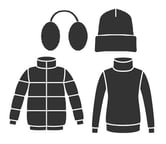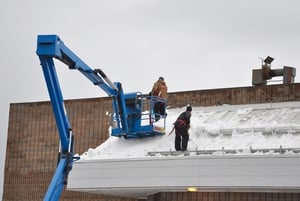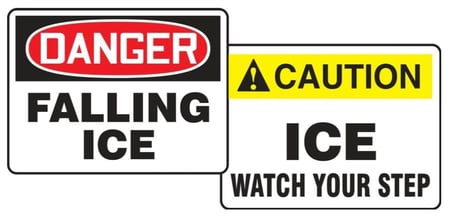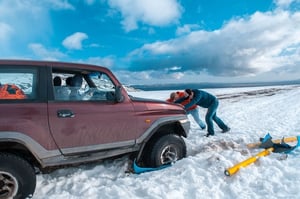Is Your Work Site Winter Ready?

To the rest of the world, the thought of falling snow brings warm thoughts of cocoa by the fireplace. To construction workers (or anyone that works outside), it’s a bleak reminder that cold weather can bring annoying, dangerous and even deadly working conditions.
Work doesn’t stop just because the temperatures outside hit record lows. In fact, winter weather can make the same job harder and more dangerous. Safety managers have a tough job protecting workers during this time. But, it is possible. Before you get started creating a winter safety program for your workplace, you need to understand exactly what you’re dealing with.
Avoid These Cold Weather Exposure Hazards
|
|
- For more quick ideas to get your worksite winter ready, check out these helpful solutions.
Mother Nature’s Impact on Slips, Trips and Falls
Maybe you’re not convinced that slips, trips and falls are a big deal in the winter months. Maybe you think anyone who falls on a little ice is either clumsy or has their head stuck in their smartphone. Well, maybe that’s a little true. Still, workers are hurt every day from icy conditions.
Take a look at just a few of the causes of slips, trips and falls:
|
|
In 2014, there were over 34,860 jobsite injuries from falls on ice, sleet and snow. And 28% of those ended up out of work for over a month! If you want to avoid unnecessary injuries, illnesses and death, it’s time to prepare now.
4 Tips to Winterize Your Work Area and Protect Workers

Tip # 1: Assess Workers' Safety Needs
In cold weather, you better make sure your crew is suited up and ready to battle the blustery conditions. When was the last time you assessed their personal protective equipment? Do they have the gear they need to stay warm AND safe?
Let’s take a look at some ways you can improve worker safety on your work site.
| A. Footwear: | |
| Does your crew have slip-resistant boots and shoes? Are their boots water-resistant? Will their boots stand up to other hazards of the job like punctures, impact or electrical shock? It should never be a guessing game when it comes to choosing foot protection. (Check out this quick guide to boot selection!) Even with the best foot protection, your workers need added grip when working on icy surfaces. Ice cleats dig into the ice and provide the extra traction they need to stay on their feet. And, there’s a ton of choices out there to fit every need and every shoe. |
|
 |
B. Clothing and Apparel: |
| It’s not just the cold that workers need to protect against. Their workday can be cold, wet and dangerous. That’s why the right clothing can make all the difference in the world. Clothing should keep them warm and dry, but also protect them against day-to-day risks, like electrical shock, arc flash, flash fires and low-visibility. Teach workers the proper way to layer their gear to stay comfortable and protected. In arc flash situations, it’s important that all layers of clothing be arc-rated, including base layers. If not, the results could be devastating. Hand and foot warmers are another simple solution that can give workers some comfort in harsh conditions. |
|
| C. Hydration: | |
| Think dehydration is just something you need to worry about in the hot summer months? WRONG! Dehydration can be very common even when temperatures outside have us shivering in our boots. In the winter months, sweat can evaporate off our skin more rapidly and can lead to increased risk of dehydration. The reason? Workers are less thirsty, so they tend to drink less fluids. The kicker? Not only are workers taking in less water, cold conditions cause their urine output to increase. Plus, the extra weight from boots, jackets and long underwear can increase perspiration. That means it’s more important than ever to HYDRATE. Give workers plenty of options when it comes to hydrating themselves during the workday. Set up hydration stations throughout the site for quick and easy access. Provide cold and warm drinks that can quench their thirst and replenish important electrolytes. |
|
| D. Adequate Time Indoors: | |
| Workers will need places to take refuge from the cold, even if it’s just a temporary shelter. Offer areas that workers can take frequent short breaks in warm, dry areas. |
Tip # 2: Have a Snow and Ice Removal Program

This may sound like common sense, but hang on just a minute. Removing snow from surfaces like a roof or near power lines and equipment can be dangerous business. That’s why you need to make sure workers know the RIGHT way to remove snow and ice.
- Ice and snow removal should occur BEFORE people arrive on site.
- Treat icy areas with ice melt products to reduce time and energy spent.
- Workers should wear high-visibility gear when removing ice and snow in high traffic zones.
- Train workers to use snow rakes, drag lines, ladders, aerial lifts and fall protection properly.
Even shoveling snow on the ground level can lead to pulled muscles, cold stress and overexertion. Even though we may crack up at some of these slip and falls, when it happens at work — it’s no laughing matter.

Tip # 3: Mark Off “No Go” Areas
No matter how hard you try to eliminate hazards on the job, sometimes it’s impossible to remove them all. Rather than crossing your fingers and hoping for the best, take a few steps to be certain your workers don’t accidentally wander into danger zones.
Clearly mark off dangerous zones with:
- Floor marking tape
- Flags & Warning Lines
- Barricade Tape
- Guardrails
- Signage
Tip # 4 Be Prepared for Worst Case Scenario

Have the potential to get stranded on a job site? Anytime you’re on the road, you need to plan for your safety — especially in cold, winter months. That means having a Self-Rescue Safety Kit ready and on hand. Self-rescue means you can try to get yourself out of a bad situation, before it gets worse.
How? Having a shovel, tow rope and some kitty litter in the bed of your truck can help you pull your vehicle out when snowed in. What if you have to stay where you are? Then, you’ll wish you had packed these life-saving items in your kit:
- First aid supplies
- Blankets
- Water
- Food
- Tracking Device
- Two-Way Radio
- Road Salt or Kitty Litter
- Emergency Flares
Being prepared with these items will help you survive until help arrives. Keep family and coworkers in the loop of your location in bad weather, so people will know where to start looking for you.
It’s not a bad idea to have a two-way radio set up in your truck, either. You don’t want to have to rely on bad cell phone reception when you’re stranded in the middle of nowhere.
Visit our Bacon’s Safety Tip on Winter Safety Kits for more help on what you need to stay safe!
The better you know the risks, the better you’ll be prepared. If you ever need a hand figuring out the best safety solutions for your workers, just ask the pros at Quad City Safety. It’s what we do.
Safety: It’s Your Life, It’s Our Business








